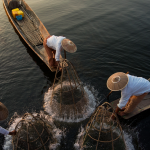A team of researchers at the Spanish Institute of Oceanography in Vigo have completed the world's first octopus growing cycle, bringing octopus farming one step closer to commercialization.
The first achievement in octopus culture research came in 1995. Yet it wasn't until 2001 when researchers managed to rear octopus paralarvae in captivity. This milestone enabled the team to find the most effective type of juveniles for subsequent repopulation projects.
Octopus is a born predator. Starting life as paralarvae measuring 3 millimeters in length and weighing 1 milligram, the species has a highly developed sense of vision and eight arms with three suction cups to catch their prey. At this stage it is a planktonic animal living near the surface.
The team observed natural octopus movements and positions when hunting for prey, and the way their arms surround their victim, injecting a paralyzing enzyme. The suction's digestive system softens the internal tissues and the prey is absorbed. In the culture tank, however, the death rate for cephalopod hatchlings is high with slow growth. The team said this is because they're not receiving the full food intake.
Javier Sánchez, director of the study, explained that the problem is complicated by "the lack of equipment dedicated to this type of research. Each laboratory develops a different methodology which makes it difficult to compare results."
The various tests are carried out in 100-liter tanks enabling many replicas to be made. "The greater the volume, the better the results," said researcher Lidia Fuentes.
Right now the team is working on intensive cultivation of paralarvae and the importance of lipids and proteins in the larval diet "to test and bio-chemically analyze both the paralarvae and prey," said Fuentes.
The most critical stage in the breeding process is the first two months; 800,000 paralavae were released in a Vigo estuary and fed live brine shrimp and crab zoeae. Two reached adulthood and a female of almost 2 kilograms had a set of 112,000 eggs before dying. Due to natural death or predators, only one adult survived.
"To produce adult octopus, it follows from this that the main problem is nutrition at the larval stage," said Sánchez.





